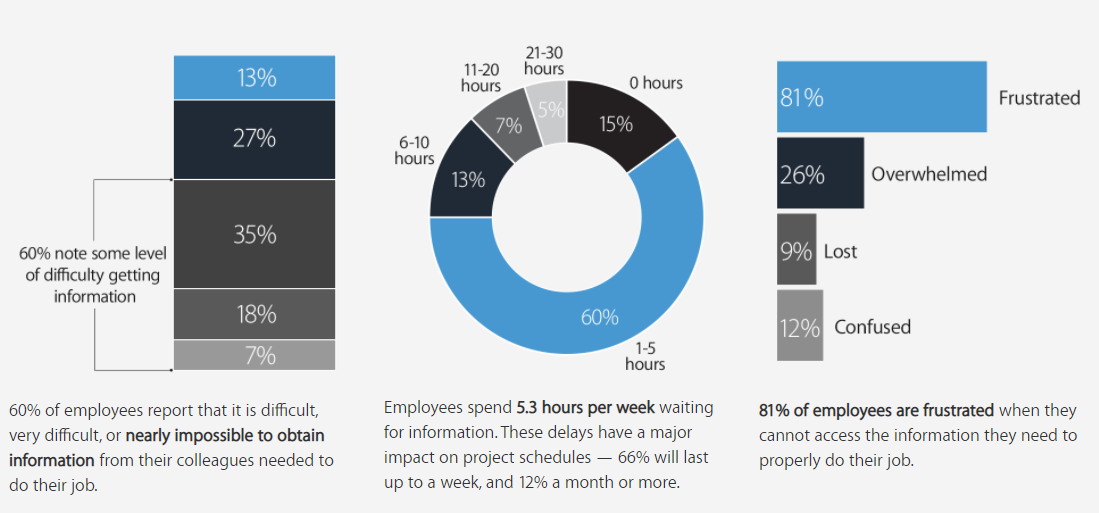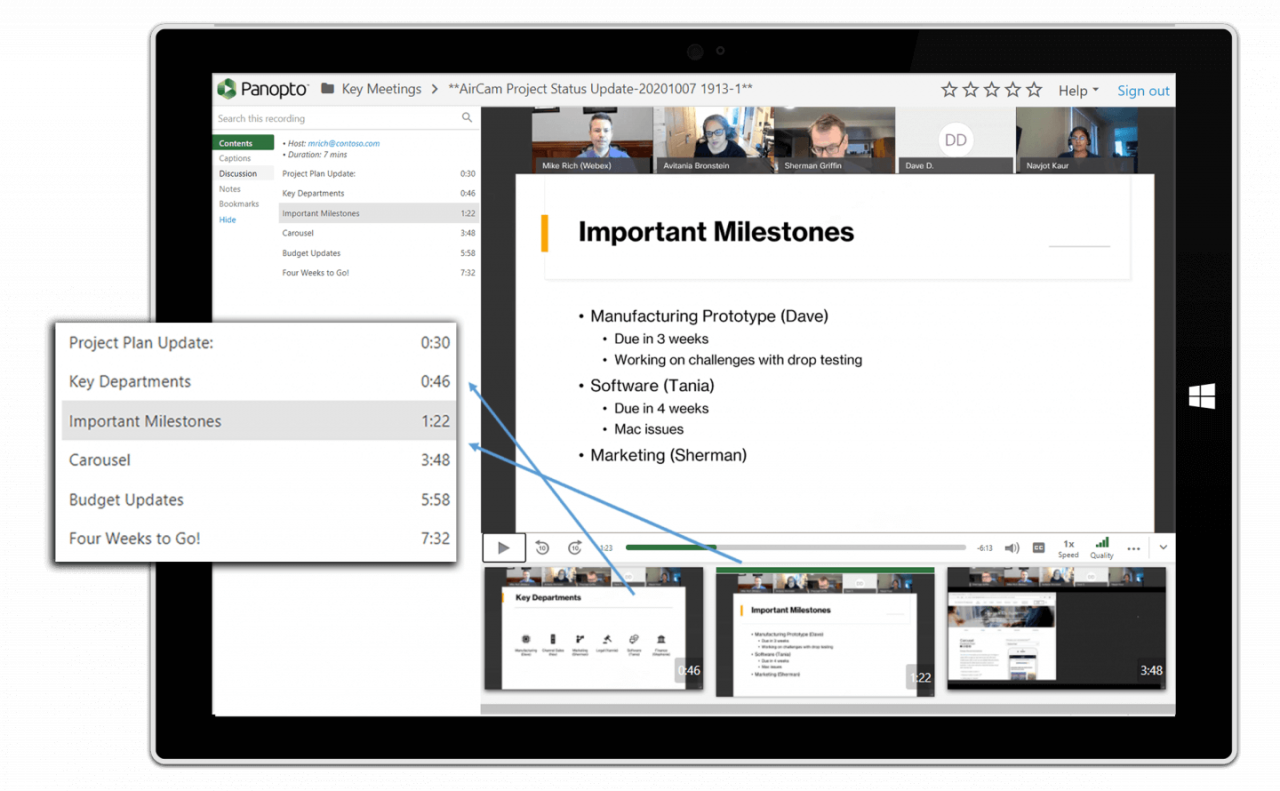- Collaboration
How To Help Remote Teams Share Knowledge Effectively

Business leaders have enacted various strategic measures over the last few decades to improve collaboration and knowledge sharing among their employees. From open-floor office spaces and brown-bag lunches to content management systems and digital communications technologies, knowledge management structures continue to evolve with the goal of holding on to institutional knowledge and helping the right people get the right information at the right time.
The recent pandemic-driven shift to remote work adds a new twist to a familiar problem: how to efficiently capture and share knowledge so information can flow seamlessly throughout a geographically dispersed workforce.
With distributed teams who now only see each other through video conferences, business leaders worry that remote work poses a significant threat to knowledge sharing throughout their organizations.
Why Knowledge Management is Critical in a Remote Work Environment
The very nature of remote work adds new complexity to the flow of knowledge — people, information, and resources become both physically and digitally scattered, making it difficult for others to easily locate and acquire information. Tacit knowledge, the valuable experiential and intuitive know-how employees possess, is even harder to capture and share across distributed teams. And when critical insights aren’t available at the moment of need, it cuts deeply into productivity and employee satisfaction.
Fully remote teams also miss out on opportunities to engage in unplanned collaborative exchanges that occur organically in a physical office — there is no one sitting nearby to turn to for a quick discussion or walk-through, no philosophical conversations over lunch, and no catching up with a colleague in another department while waiting by their desk for a conference room to open up.
The flow of knowledge from peer to peer that not only boosts productivity but also supports continual learning and rapid adaptation evaporates in a remote work environment. And the loss of casual collaboration, along with the increased time and effort it takes to track down information, can cause remote employees to disengage as they begin to feel more isolated and frustrated.
The Cost of Inefficient Knowledge Sharing
The value of sharing knowledge may be difficult to measure and often overlooked, but thanks to a first-of-its-kind study on Workplace Knowledge and Productivity, we have a better understanding of how knowledge management practices truly impact a business.
Recently, Panopto and YouGov surveyed 1,001 American employees across a variety of industries to learn how access to institutional knowledge, or the lack thereof, affects day-to-day work. The results were staggering.
Companies of every size waste millions of dollars every year sharing knowledge and information inefficiently. In a company of 5,000 employees, it is estimated that $13.3M is lost annually to poor knowledge sharing practices that don’t help employees quickly find answers when they need them. In an organization of more than 100,000 employees, that figure jumps to $265M a year.
Use our calculator to find out how much your business is losing each year to inefficient knowledge sharing practices >>
The time workers spend on average each week waiting or looking for information, as well as the time spent duplicating efforts adds up quickly across an organization. Many people spend roughly half of their work week being far less productive than they could be if their organizations had better knowledge management structures:
- Employees spend an average of 5 hours each week just waiting to get in touch with a colleague who has unique knowledge they need.
- Employees report spending an average of over 8 hours a week — an entire work day — searching for and acquiring knowledge.
- Employees reported spending nearly 6 hours each week “reinventing the wheel” and duplicating other people’s work. Almost 1 in 3 say they spend more than 6 hours every week on redundant tasks.

Download the Workplace Knowledge and Productivity Report >>
Rethinking Knowledge Management For A Remote Workforce
Knowledge has been and will continue to be a key competitive differentiator when it comes to organizational performance. And new ways of working are challenging businesses to rethink their approach to learning and knowledge management.
Many companies today already have systems in place to shape the interactions between people and technology in ways that improve the flow of information and increase knowledge throughout the organization. Collaboration platforms, messaging apps, content management systems, purpose-built knowledge management systems, and employee incentive programs are often important components of organizational knowledge sharing structures that enable companies to achieve the following objectives:
- Capture knowledge
- Increase access to knowledge
- Promote a culture of knowledge sharing
- Manage knowledge as an asset
Fundamentally, the goals of knowledge management are the same in any work environment, so it’s worth exploring why so many organizations that have moved to remote work are seeing the flow of knowledge suffer in this new setting.
4 Reasons Knowledge Sharing Breaks Down In Remote Teams
Weaknesses in knowledge systems may be less noticeable in an office environment where in-person social interactions naturally bridge the gaps, but in a physically disconnected remote environment those weaknesses and inefficiencies become more problematic. Here’s why:
1. Social friction
Socially distant workers naturally engage in fewer activities that promote the spread of knowledge. The loss of regular in-person interactions creates social friction that can make employees hesitant to share their own personal knowledge or to ask their peers for help — whether it’s due to lack of trust, intimidation, concern they will demonstrate weakness, or the rationalization that a particular problem isn’t worth someone else’s valuable time.
2. The ‘silo effect’
A large-scale shift to remote working shrinks organizational networks as employees prioritize communicating with their immediate teammates and engage less with colleagues they do not work with regularly. Additionally, when data and documentation is not digitally centralized across an organization, outside teams may not be able to easily access knowledge that exists — if they even know it exists. Ultimately, the lack of communication and information sharing between departments and teams creates a harmful silo effect that diminishes productivity and stifles innovation.
3. Knowledge captured is incomplete or not captured at all
Knowledge is often shared in meetings and presentations that include slides, spreadsheets, and other written documents, which can be digitally stored and shared for easy reference later if someone needs to refresh their memory. But those supporting files are incomplete without the accompanying presentation and many employees will spend extra time trying to track down information from remote colleagues to fill in the blanks when they need answers.
The isolation and sporadic interaction with teammates that is common in a remote work environment can also decrease the awareness workers may have regarding the value of their own expertise or knowledge. Unless they are specifically asked for help or asked to share, it may never occur to someone that taking the time to capture and communicate what they know could help others within the organization.
4. Knowledge resources become scattered and unorganized
Curating and codifying knowledge resources always begins with the best intentions, but organizations frequently end up with multiple knowledge repositories that are used in varying ways by different teams and departments. While there may be an abundance of knowledge assets that could support workers, they may be difficult to find, difficult to access, and even outdated. Pivoting to remote work with disorganized and disconnected knowledge repositories not only hurts the flow of knowledge throughout the organization but also contributes to remote employees feeling frustrated, unproductive, and disengaged.
The Secret To Keeping Knowledge Flowing Across A Distributed Workforce
Knowledge management is the practice of connecting workers with searchable knowledge assets, and connecting people to exchange knowledge. When you need to put people and their knowledge at the fingertips of your distributed workforce, regardless of their time zone or location, there’s no better solution than a searchable video knowledge base.
You’ve heard the saying, “A picture is worth a thousand words.” Well, according to Forrester Research, a one-minute video is worth 1.8 million words.
Recording a video makes it easier for employees within your organization to show what they know in much less time than it takes to create a comprehensive document with the same amount of information. Simply pressing “record” on a video conference can also enable teams to capture and archive knowledge in an instant. And with innovative video search and discovery tools, it’s as easy for remote workers to find answers deep inside a video as it is likely they’ll discover new ideas and information in the everyday flow of work.
A video platform like Panopto integrates easily into content management and collaboration tools so you can create a video-enhanced knowledge sharing ecosystem that helps overcome the unique challenges of sharing knowledge in a remote work environment. Video-based knowledge resources put your people and their expertise front and center, which helps foster social connections across physically distant teams, lifts morale and productivity along the way, and also makes knowledge and information really easy to find at any moment.
Dive deeper into how you can use Panopto’s secure video platform to enable effective and efficient knowledge sharing across remote teams.
How To Use On-Demand Video To Improve Remote Knowledge Sharing Practices
Empower everyone to share knowledge simply by pressing “record.”
From the CEO to the summer intern, Panopto’s easy-to-use video and screen recorder empowers employees to quickly record multi-camera video presentations, video tutorials, how-tos, online meetings, video documentation, demonstrations, explainers, training sessions, and more with just their laptop or smartphone — putting their personal expertise on display for anyone in the company to see.

Visit Panopto Express and see how easy it is to record what you know. When you’re done recording, click “Send to Panopto” then invite your colleagues by email to view it.
Start a Recording >>
Reduce the time and effort it takes to acquire knowledge and find answers.
Your people want the quickest path to the answers they need so they can stay productive and do their best work. Panopto helps your organization centralize and search robust video-based knowledge assets so information can be found instantly. Every meeting or video your employees record with Panopto is automatically uploaded and transcribed for search, making anything said or shown on the screen searchable. Panopto also supports video search in fifteen languages. And when you integrate Panopto with other business systems such as Slack, Salesforce, your content management system (CMS), or your learning management system (LMS), employees can search, watch, and share videos wherever they are working.
Panopto enhances video content in other ways to make details easier to extract quickly:
- Automatically creates a clickable summary so viewers can skim through and skip around a longer meeting or video
- Adds visual thumbnails of the video that also enable viewers to quickly extract information from slides or other visuals
- Automatically captions videos to support comprehension, particularly for viewers watching content that isn’t presented in their native language
- Content creators can embed links, documents, presentation slides, and more that viewers can access or download right from the video
- Timestamped comments and discussions within a video can provide viewers with updated information and additional insights — viewers can even leave comments themselves
- Video tags offer viewers a clickable link to related content that can reveal additional information

Make virtual knowledge sharing social with a YouTube-like video portal.
In addition to learning from colleagues who they can see and hear in on-demand videos, Panopto gives remote workers new opportunities to expand their social networks and engage with experts throughout the organization much like they can on YouTube. Through Panopto’s video portal and interactive video player, employees can comment and have discussions inside videos, subscribe to colleagues and subject matter experts, subscribe to tags, and even rate the videos they watch.
What’s more, those sharing knowledge and information can tag their videos to make them more visible within the organization and they can view detailed viewing analytics for their content, which makes the value of their knowledge and ideas more tangible. Ultimately, Panopto’s video platform is designed to engage your workforce in a continuous cycle of sharing knowledge.

???? Learn how Ingersoll Rand utilizes Panopto to rapidly share knowledge and information.
View the case study >>
Minimize information silos and maximize the discovery of cross-departmental insights.
You don’t know what you don’t know. Panopto helps your organization break down information silos so remote employees can more easily learn what’s happening in other departments and teams. Administrators can curate content to highlight knowledge resources and informative communications from across the organization that appear right in the employee’s video portal homepage. Leaders can also leverage subscriptions and tags to create video content streams from their departments that keep others up to date on initiatives, innovations, deliverables, progress to meeting goals, and more.
Confidential video-based knowledge and information can be captured and shared just as easily, without having to worry about who might see it. With fine-grained controls for permissioning that can be set for individual videos, folders, and your entire knowledge library, Panopto will only reveal video content through search and discovery to users who have viewing permission — every recording in your video knowledge base is private and secure by default so you’ll never worry about sensitive video content leaking outside of your organization either.
Analyze and learn from knowledge sharing behaviors.
Panopto’s comprehensive suite of video analytics provides knowledge managers and other business leaders with valuable information that reveals knowledge sharing behaviors at the organizational, departmental, and individual levels. Video analytics data can also be used to help reward and reinforce the knowledge sharing behaviors that will make your company agile and successful. You can even send video viewing data to your LMS.

With Panopto, you’ll gain new and actionable insights into how knowledge is used and how it’s impacting your company.
Solve your toughest knowledge management challenges.
Contact our team for a customized demo of Panopto Enterprise and get started with a free trial today.



